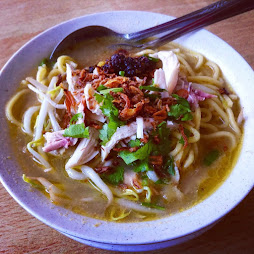Once known as the Malay Emporium of Singapore and although it was developed later than the more glamorous and historical
Kampong Glam, Geylang Serai has long been associated with the Malay community of Singapore with history of the area dated back to early 19th century. It is one of the oldest Malay settlements in Singapore.
Located between Changi Road and Sims Avenue, the main attraction of the greater Geylang Serai is the busy Geylang Serai Market, affectionately known amongst the Malays as Pasar Lama (old market). Pasar Baru (new market) is the opposite building called Joo Chiat Complex, which was completed in 1985 on the site of the former Changi Market. Designed like a traditional Malay house, Geylang Serai Market comprises two storeys consisting of a wet market on the ground floor and a cooked
food or hawker centre on the upper floor. It was first opened in 1964 by the first prime minister of Singapore Lee Kwan Yew. It was redeveloped in 2009 and reopened in 2010.
It is the go-to place for the Malays for the variety of fresh groceries, vegetables, meat, poultry and seafood and of course delicious and affordable Malay food, snacks called kueh or dishes. All food and dishes at the market are halal. Of course, not only Malays who go there. The variety of fresh produce attracts people from everywhere especially those staying nearby.
 |
| Geylang Serai Market |
The best time to go to the market is in the morning from 7am onwards for fresh produce and to tuck into delicious Malay snacks and dishes for breakfast at the hawker centre upstairs. There are stairs to go up to the hawker centre as you can see from the photo above and there is also a lift or elevator somewhere in the middle of the market. Convenient for those who need a lift up to the hawker centre after or before doing marketing at the ground floor.
The area 'Geylang' is derived from a river called the Geylang River, a canalised river which now formed part of the larger Marina Reservoir. Some of the earliest spellings found in the 19th century maps annotated the area as 'Gellang' or 'Gelang'.
 |
Food/ hawker centre at Level 2
|
These spellings indicate that Geylang River was likely named after a specific tribe of the Orang Laut (sea nomads), Orang Gelang, who settled along the riverbanks and originally hailed from the islands in the Riau archipelago of Indonesia. 'Orang' literally means people in Malay.
Gelang also means bracelet or anklet in Malay. The word Geylang could also have come from the word 'gelanggang' which means 'arena' as cock-fighting matches were said to be held there in the past. Cockfighting, village entertainment of yesteryear has long gone. And finally, 'Geylang' could also have been derived from the word Malay word 'kilang' which means 'factory'.
The current spelling of 'Geylang' was formalised only in the 1930s when the colonial government started using the the current spelling in survey maps. There are storyboards on the second floor of the market in-between the
hawker centre and the stalls selling traditional clothes which tell interesting historical stories of the place and the wider area in general.
 |
| An assortment of Malay kueh and snacks |
Serai is the Malay word for lemongrass or citronella plants, a major crop in the area during the late 19th century, in a plantation called Perseverance Estate. This plantation was located between Paya Lebar Road and Jalan Eunos and was only accessible by Geylang Road. As a result, the area became closely associated with lemongrass and citronella. So, when you put the two words together, Geylang and Serai, it could simply be lemongrass bracelet, lemongrass factory, or lemongrass cock-fighting arena. One would think lemongrass factory makes the most sense.
In-between the 1830s till early 1900s, many of the eastern district of Singapore including Geylang consisted of plantations with a variety of cash crops such as cotton, coffee, sugar, nutmeg, gambier and pepper and the most successful plantation was the cultivation of lemongrass and citronella and there were citronella distilling factory that was made into essential oils in the late 1800s till its closure in the early 1900s. Following the demise of the lemongrass and citronella industry, coconut palms, another cash crop, were cultivated in Geylang Serai.
 |
| Geylang Serai Wet Market at Level 1 |
The area that is now considered as Geylang Serai covered an area bounded by Paya Lebar Way, Aljuneid Road, Guillemard Road, Dunman Road, Joo Chiat Road and of course Geylang Serai Road. Historically Geylang Serai also include Kampong Ubi. However today, Geylang Serai proper refers to the market and the housing flats bounded by Sims Avenue, Changi Road, Geylang Serai Road and Jalan Turi. Historically also Geylang Serai Road was formerly known as Jalan Alsagoff.
Engku Aman Road which runs parallel to Geylang Serai Road is named after Abdulrahman bin Taha Alsagoff, a philanthropist and landowner who arrived in Singapore in 1848. He held the title "Engku" as he was of the Bugis royal descent who contributed the Alsagoff Arab School and the reconstruction of the Hajjaj Fatimah Mosque in
Kampong Glam. The mosque was founded by his great-grandmother, a Malacca merchant who was also the Sultana of Gowa in Sulawesi.
 |
| Dry and salted fish, squid and shrimps |
Most stalls at the Geylang Serai wet market on the ground floor and the hawker centre at the upper floor will wrap up by 3pm in the afternoon. There is Mr. Teh Tarik food centre on the ground floor of the market on the left-hand side, that opens 24-hr. So, a food-court within a bigger market to cater to hungry persons all day long, or just for a sip of frothy
teh tarik.
Wet market refers to open fresh produce market as opposed to air-conditioned supermarkets. Pricewise, the wet market offers cheaper produce than supermarkets and the produce tend to be fresher too. At the same time the market vibe is certainly more vibrant. The terms wet market and hawker centre are kind of unique in Singapore and some visitors may not be able to comprehend.
On the ground floor there also is frozen food store that sells an array of frozen meat and snacks. There is also a bakery and fruit stalls. At the second floor apart from the
hawker centre you will find stores selling traditional garbs such as
baju-kurung, batik sarong and accessories. Many groceries or dried sundries stalls at the ground floor wet market area also sell pre-prepared spices or freshly grounded spices such as for making Malay cuisines such
rendang,
asam pedas and
lemak gravy, so you do not have to prepare yourself.
 |
| Putu piring |
You can find the popular sweet and caramelised palm sugar-filled steamed rice,
putu piring for only $2.50 for five pieces at Geylang Serai market at the ground floor at Traditional Haig Road Putu Piring within Mr. Teh Tarik food-court. This famous putu piring made its way into the Netflix Street Food series. 'Piring' is a Malay word for plate. As the putu is shaped like a UFO or a plate, hence it is called putu piring. There are also putu made in a cylindrical round mould, simply called putu or kueh putu. Putu piring is topped with freshly grated coconut and small pieces of pandan leaves as garnish and fragrance.
There are also stalls selling fried banana or yam fritters, 'epok-epok' or curry puffs and 'cempedak goreng' or fried artocarpus integer, which is a family of jackfruit, sell for only $2 for four to five pieces each at the food-court. And Alhambra satay can also be found in this 24-hr food-court.
 |
| Baru kurung at level 2 Geylang Serai |
Epok-epok usually contains potatoes but there is also epok-epok sardines, which contains sardines. And there is also 'epok-epok sayur' which contains vegetables, usually taugeh (bean sprouts). You dip epok-epok sayer in a chilli sauce. There are also curry puffs that contain eggs and potatoes like the ones sold by Old Chang Kee.
The Latin American versions of epok-epok is empañada. And the Indian version is
samosa. Wonder who invented first. I have tried empañada, samosa and 'karipap' and epok-epok, they are all equally delicious. Perhaps the Americans or British versions are the pies?
 |
| different types of bananas or pisang |
Looking for fresh bananas or banana fritters? There are many types of bananas, which is a common tropical fruit, grow very well in any tropical climate including Singapore. For the bananas fritters they usually are from the
kepok or
nipah or
tanduk types.
Other types of bananas are
pisang emas,
pisang nangka and
pisang raja.
Raja means king.
Tanduk is horn.
Emas is gold.
Nangka is jackfruit. Not literally.
Pisang is a malay word for banana. And there are red bananas too, apparently sweeter and supposedly contain more nutrients.
For
epok-epok there is a bigger version of curry puffs and it's called
karipap. It can be triangle or the rectangular version. And the various types of
karipap can just plain be potatoes, or the chicken, mutton and even the rendang versions.
Rendang is a popular Malay/ Indonesia dish. Price is between $1 to $1.80 depending on types.
 |
| Kway Guan Huat Popiah at Joo Chiat |
A couple of popular karipap (the Malay style of pronouncing curry puffs) stores called Shazah and Imran Confectioneries can be found along Joo Chiat Road. You can buy them freshly baked, straight from the oven. Other than curry puffs along Joo Chiat Road you can also find the famous
popiah or spring rolls and Kueh pie tie store called Kway Guan Huat. Kway Guan Huat has been around since 1938. You can also buy popiah skins directly from them.
Joo Chiat Road has some unique shophouses in Peranakan architecture. Joo Chiat Road was gazette as a conservation area in 1993. You can also find the popular Hajah Maimunah restaurant, famous for
nasi ambeng, along Joo Chiat Road opposite
Pasar Baru, Joo Chiat Complex, for traditional Malay dishes. You can easily spot it with its long snaking queue especially during lunchtime.
Do you know that Hajah Maimunah Restaurant is listed in the Michelin Bib Gourmand? They have another outlet along Jalan Pisang, at the historical
Kampong Glam. Do check out The Vadai Shop just a few units further up Hajah Maimunah. It sells crispy deep-fried vadai dough, can be plain or the favourite classic shrimp. This shop also usually has longlined. Vadai or wadai is a staple of
pasar malam or night market.
 |
| Longline at Hajah Maimunah |
Joo Chiat Complex, or Pasar Baru, is a shopping complex that sells clothing materials, curtains, Malay traditional garbs, traditional medicines. There are also stores selling household items and jewellery such as gold. Joo Chiat Road is quite a fascinating road leading towards Katong area, a Peranakan enclave. So, the area is indeed a fusion between Malay and Chinese which reflect the multi-cultural society of the city.
If you are looking for kitchenware and cooking utensils, there is a shop called 5B (five brothers) along Joo Chiat Road that have all sorts of kitchen tools or wares that you need. And just a bit further down this shop there is also a historical mosque called Masjid Khalid that was built in 1917 on a wake or donated land by Haji Abdul Khalid bin Haji Mohamed Taib, hence the name.
Do you know that electric trams used to run along Joo Chiat Road? In the 1890s, when the citronella market declined, the lemongrass grass factory was closed, and its site was converted into an eastern terminal for Singapore's first tramline. In the early days there used to be
wayang shows, open-top cinemas and shophouses selling wooden clogs. Wooden clogs were fashionable back then, as the sound made the clogs were used to scare away bad spirits. Joo Chiat Road was named after Chew Joo Chiat, a migrant turned wealthy philanthropist from China who was a plantation owner, cultivating gambier, nutmeg and coconut, the economic cash crops, in the early 1900s. And somewhere in the middle off Joo Chiat Road is Koon Seng Road with its pretty two rows of pre-war terrace houses. These ornate terrace houses display some of the finest examples of Peranakan architecture in Singapore.
 |
Otak-otak
|
Do come to Geylang Serai during the month-long fasting month of Ramadan to see the colourful light-up and Hari Raya bazaar
a la
night market or pasar malam style, but in a bigger scale. There is also bazaar during Ramadan at
Kampong Glam though the bazaar runs in late afternoon and will wrap-up by breaking fast time. So, you can go from Kampong Glam to Geylang Serai to enjoy the festive atmosphere.
Hari Raya is not a Malay or Muslim New Year's Day. Hari Raya Puasa, also known as Hari Raya Aidil Fitri, actually falls on the 10th month of Islamic calendar and it is a celebration to mark the end of the fasting month.
 |
| Milo Dinosaur |
Nearest MRT station is Paya Lebar. There are some new developments around the area such as One KM near Geylang Serai, but older residents will always have a soft spot for Geylang Serai. Would you have a cup of coffee or tea in a modern air-conditioned mall or enjoy your
teh-tarik in a traditional hawker centre? And how about a cup of icy
milo dinosaur? A chocolate drink fit for a dinosaur.
So, it can get nostalgic for the older Malay residents who go to Geylang Serai to savour some traditional Malay kueh or snack. Other than Geylang Serai
hawker centre, the nearby Haig Road Hawker
Centre is also a popular foodie place for malay food. You can try the popular
mee rebus and satay there.
 |
| Huge Gendang at Wisma Geylang Serai |
So, if you have not heard of
naga sari,
lepat,
pulut panggang,
kueh koci,
otak-otak or
kacang pool, head to Geylang Serai. Or if you just want to browse around the wet market and produce to admire the morning activities, you can check out
ikan selar or
ikan tuning, the fishes which are typically found in the traditional coconut milk rice,
nasi lemak.
Do head to the Geylang Serai Heritage Gallery at Wisma Geylang Serai, a cultural hub building located just across the street next to the market. It is a community gallery, sort of a mini museum, that contains the histories of the area as well as some artifacts. Entry is free, opens from Tuesday to Sunday from 10am to 6pm. Indeed, Geylang Serai and Joo Chiat has lot of things to do and see. You can easily spend half a day wandering around the area.















Comments
Post a Comment